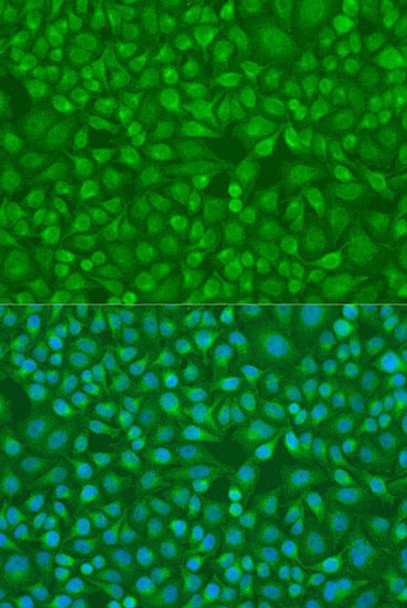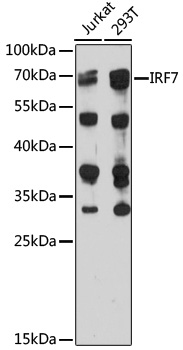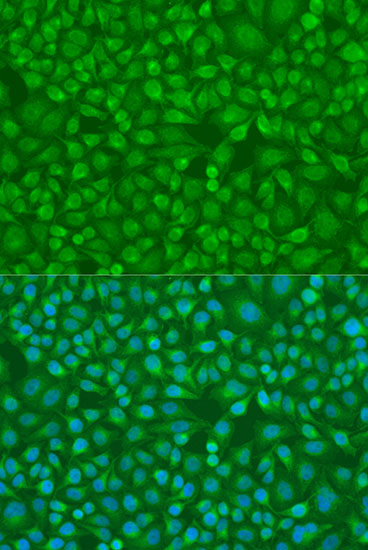Anti-IRF7 Antibody (CAB0159)
- SKU:
- CAB0159
- Product type:
- Antibody
- Reactivity:
- Human
- Reactivity:
- Mouse
- Host Species:
- Rabbit
- Isotype:
- IgG
- Antibody Type:
- Polyclonal Antibody
- Research Area:
- Immunology
Description
| 抗体名: | Anti-IRF7 Antibody |
| 抗体コード: | CAB0159 |
| 抗体サイズ: | 20uL, 50uL, 100uL |
| 申し込み: | WB IF |
| 反応性: | Human, Mouse |
| 宿主種: | Rabbit |
| 免疫原: | Recombinant fusion protein containing a sequence corresponding to amino acids 257-516 of human IRF7 (NP_004022.2). |
| 申し込み: | WB IF |
| 推奨希釈: | WB 1:500 - 1:2000 IF 1:50 - 1:200 |
| 反応性: | Human, Mouse |
| ポジティブサンプル: | Jurkat, 293T |
| 免疫原: | Recombinant fusion protein containing a sequence corresponding to amino acids 257-516 of human IRF7 (NP_004022.2). |
| 精製方法: | Affinity purification |
| ストレージバッファ: | Store at -20'C. Avoid freeze / thaw cycles. Buffer: PBS with 0.02% sodium azide, 50% glycerol, pH7.3. |
| アイソタイプ: | IgG |
| 順序: | PSPG PQPA ALTT GEAA APES PHQA EPYL SPSP SACT AVQE PSPG ALDV TIMY KGRT VLQK VVGH PSCT FLYG PPDP AVRA TDPQ QVAF PSPA ELPD QKQL RYTE ELLR HVAP GLHL ELRG PQLW ARRM GKCK VYWE VGGP PGSA SPST PACL LPRN CDTP IFDF RVFF QELV EFRA RQRR GSPR YTIY LGFG QDLS AGRP KEKS LVLV KLEP WLCR VHLE GTQR EGVS SLDS SSLS LCLS SANS LYDD IECF LMEL EQPA |
| 遺伝子ID: | 3665 |
| Uniprot: | Q92985 |
| セルラーロケーション: | Cytoplasm, Nucleus |
| 計算された分子量: | 18kDa/51kDa/54kDa/55kDa |
| 観察された分子量: | 70kDa |
| 同義語: | IRF7, IMD39, IRF-7H, IRF7A, IRF7B, IRF7C, IRF7H |
| バックグラウンド: | IRF7 encodes interferon regulatory factor 7, a member of the interferon regulatory transcription factor (IRF) family. IRF7 has been shown to play a role in the transcriptional activation of virus-inducible cellular genes, including interferon beta chain genes. Inducible expression of IRF7 is largely restricted to lymphoid tissue. Multiple IRF7 transcript variants have been identified, although the functional consequences of these have not yet been established. |
| UniProt Protein Function: | IRF7: Key transcriptional regulator of type I interferon (IFN)-dependent immune responses and plays a critical role in the innate immune response against DNA and RNA viruses. Regulates the transcription of type I IFN genes (IFN-alpha and IFN-beta) and IFN-stimulated genes (ISG) by binding to an interferon-stimulated response element (ISRE) in their promoters. Can efficiently activate both the IFN-beta (IFNB) and the IFN-alpha (IFNA) genes and mediate their induction via both the virus-activated, MyD88- independent pathway and the TLR-activated, MyD88-dependent pathway. Required during both the early and late phases of the IFN gene induction but is more critical for the late than for the early phase. Exists in an inactive form in the cytoplasm of uninfected cells and following viral infection, double-stranded RNA (dsRNA), or toll-like receptor (TLR) signaling, becomes phosphorylated by IKBKE and TBK1 kinases. This induces a conformational change, leading to its dimerization and nuclear localization where along with other coactivators it can activate transcription of the type I IFN and ISG genes. Can also play a role in regulating adaptive immune responses by inducing PSMB9/LMP2 expression, either directly or through induction of IRF1. Binds to the Q promoter (Qp) of EBV nuclear antigen 1 a (EBNA1) and may play a role in the regulation of EBV latency. Can activate distinct gene expression programs in macrophages and regulate the anti-tumor properties of primary macrophages. Monomer. Homodimer; phosphorylation-induced. Heterodimer with IRF3. Interacts with TICAM1 and TICAM2. Interacts with rotavirus A NSP1; this interaction leads to the proteasome- dependent degradation of IRF7. Interacts with Epstein-Barr virus LF2. Interacts with MYD88 AND TRAF6. By type I interferon (IFN) and viruses. Expressed predominantly in spleen, thymus and peripheral blood leukocytes. In the absence of viral infection, maintained as a monomer in an autoinhibited state and phosphorylation disrupts this autoinhibition leading to the liberation of the DNA- binding and dimerization activities and its nuclear localization where it can activate type I IFN and ISG genes. Belongs to the IRF family. 4 isoforms of the human protein are produced by alternative splicing. |
| UniProt Protein Details: | Protein type:DNA-binding; Transcription factor Chromosomal Location of Human Ortholog: 11p15.5 Cellular Component: nucleoplasm; cytoplasm; endosome membrane; cytosol; nucleus Molecular Function:protein binding; DNA binding Biological Process: transcription from RNA polymerase II promoter; positive regulation of transcription, DNA-dependent; establishment of viral latency; toll-like receptor 3 signaling pathway; negative regulation of transcription from RNA polymerase II promoter; regulation of MyD88-independent toll-like receptor signaling pathway; regulation of adaptive immune response; positive regulation of interferon-beta production; positive regulation of interferon type I production; interferon type I biosynthetic process; toll-like receptor 4 signaling pathway; positive regulation of interferon-alpha production; regulation of interferon type I production; regulation of immune response; cytokine and chemokine mediated signaling pathway; response to virus; MyD88-independent toll-like receptor signaling pathway; interferon-alpha production; regulation of MyD88-dependent toll-like receptor signaling pathway; regulation of monocyte differentiation; toll-like receptor signaling pathway; innate immune response; positive regulation of transcription from RNA polymerase II promoter; immunoglobulin mediated immune response; toll-like receptor 9 signaling pathway; response to DNA damage stimulus; interferon-beta production Disease: Immunodeficiency 39 |
| NCBI Summary: | IRF7 encodes interferon regulatory factor 7, a member of the interferon regulatory transcription factor (IRF) family. IRF7 has been shown to play a role in the transcriptional activation of virus-inducible cellular genes, including interferon beta chain genes. Inducible expression of IRF7 is largely restricted to lymphoid tissue. Multiple IRF7 transcript variants have been identified, although the functional consequences of these have not yet been established. [provided by RefSeq, Jul 2008] |
| UniProt Code: | Q92985 |
| NCBI GenInfo Identifier: | 116242593 |
| NCBI Gene ID: | 3665 |
| NCBI Accession: | Q92985.2 |
| UniProt Secondary Accession: | Q92985,O00331, O00332, O00333, O75924, Q9UE79, B9EGL3 |
| UniProt Related Accession: | Q92985 |
| Molecular Weight: | 55,635 Da |
| NCBI Full Name: | Interferon regulatory factor 7 |
| NCBI Synonym Full Names: | interferon regulatory factor 7 |
| NCBI Official Symbol: | IRF7 |
| NCBI Official Synonym Symbols: | IRF7A; IRF7B; IRF7C; IRF7H; IRF-7H |
| NCBI Protein Information: | interferon regulatory factor 7; IRF-7; interferon regulatory factor-7H |
| UniProt Protein Name: | Interferon regulatory factor 7 |
| Protein Family: | Interferon regulatory factor |
| UniProt Gene Name: | IRF7 |
| UniProt Entry Name: | IRF7_HUMAN |



